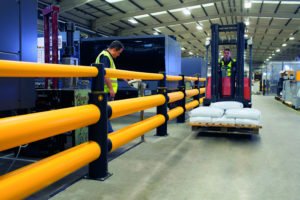Safety as a journey, not a destination, is a widely accepted construct. UKMHA Chief Executive and FLTA Director Tim Waples invites you to review that journey and asks: “are you sitting comfortably?”.
 Site safety is a precious, living thing, in constant need of care and attention. Keeping it alive and thriving requires frequent health checks and genuine commitment.
Site safety is a precious, living thing, in constant need of care and attention. Keeping it alive and thriving requires frequent health checks and genuine commitment.
Here are a few suggestions and prompts to help you evaluate the safety of your premises.
How committed are you?
In any organisation, whatever management values is what gets done. Your commitment to safety (or lack of it) is what always shines through. Your attitudes, expectations and investment are what inspire your workforce. You have the potential to empower them.
Your actions speak louder…
Safety slogans are great but creating a genuine and lasting safety culture requires resources. Improvements need to be made, and problems solved. Companies that perform well in safety also perform well in business. They recognise the financial benefits that a strong safety culture can deliver to the bottom line, seeing safety as investment, not a cost.
Set positive goals
Outline, in simple terms, what a safety culture looks and feels like for your organisation. Set some clear safety goals. Make looking forward part of the plan.
All too often we focus on lagging indicators: like accidents or near misses (i.e. the things you don’t want to see). They’re important for benchmarking where you are now, but leading indicators are just as important. Set targets for the positive changes and behaviours you want to see more of, then make them happen.
Identify opportunities for improvement
It’s easy to assume that because bad things have never happened, they never will. Smart organisations stay ahead of the curve, proactively seeking out risk factors and putting control measures in place — resolving issues before more serious problems occur.
Empower everyone
Great leaders get out onto the shop floor and into the yard. It’s where the real work gets done. Take time to chat. Offer easy, open-ended questions. You’ll gain respect and more insights than you might expect. The people doing the job usually have the answers.
Safety is your top priority. Every time.
You may have competing deadlines which create pressure to work fast. But safety should be your highest priority every time otherwise all your other measures are worthless.
So when speaking with operators, it’s not what you say, it’s the way that you say it. When you say: “I want this done safely, but I need it by lunchtime”, which part does the listener hear loudest? Switch your emphasis to safety. Always.
Get your staff involved… and informed
Creating something of value takes time and energy. In great safety cultures, every employee has a working knowledge of health and safety topics. They know their roles and responsibilities, and they recognise when things are going wrong.
FLTA Safe Site Award winner Kellogg’s is a great example of successful staff involvement and integration. Having invested hugely in making an old and complex site safer, the cereal giant recognised that toolbox talks, staff meetings and constant engagement were what really made the difference. Hearts and minds were won over. Attitudes changed. Everyone took the view that safety was their concern and took full responsibility.
Reward good work
Instead of taking positive safety behaviour for granted, let’s celebrate it. I’ve yet to meet an employee who didn’t value praise and bask in the recognition of a job well done.
Make reporting safety issues easy and guilt-free
Feedback on safety from shop floor staff is gold dust. But getting staff to speak up and criticise a colleague or even the company is a big ask. What’s needed is an environment where constructive criticism is welcomed, and where reporting is not merely guilt-free but praised. Responsibility is shared and action is taken.
No-one should fear they will be ignored or — worse still — punished for coming forward, and nothing should be swept under the carpet. In great safety cultures, transparency and integrity are undeniably fundamental.
Procedures for reporting should be clear and simple, backed by a process that deals with issues in a timely and efficient manner. Hazards can then be identified and controls put in place within reasonable timescales.
Keep it going!
Communication, communication, communication. Keep safety alive through every channel available. And make sure that safety is top of the agenda when new recruits are inducted.
And remember, success tends to breed success. When everyone is involved and participation rates are at an all-time high, you can build on the buzz… giving you further momentum for future initiatives.
Enjoy the journey!
This article was originally published on SHD Logistics.
Approaches to managing the risks associated Musculoskeletal disorders
In this episode of the Safety & Health Podcast, we hear from Matt Birtles, Principal Ergonomics Consultant at HSE’s Science and Research Centre, about the different approaches to managing the risks associated with Musculoskeletal disorders.
Matt, an ergonomics and human factors expert, shares his thoughts on why MSDs are important, the various prevalent rates across the UK, what you can do within your own organisation and the Risk Management process surrounding MSD’s.

 Site safety is a precious, living thing, in constant need of care and attention. Keeping it alive and thriving requires frequent health checks and genuine commitment.
Site safety is a precious, living thing, in constant need of care and attention. Keeping it alive and thriving requires frequent health checks and genuine commitment.